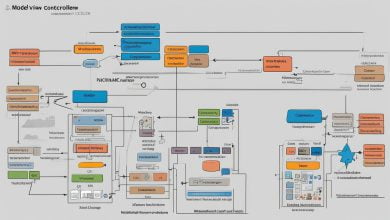In today’s fast-paced software development world, service-to-service communication is becoming increasingly important. This communication enables distributed systems to work together seamlessly and is essential for building scalable, modular applications. Azure Service Bus and .NET Microservices in C# are two technologies that can help developers achieve effective service-to-service communication.
Azure Service Bus is a cloud messaging service that can act as a message broker and queue messages for service-to-service communication. .NET Microservices in C# are a set of small, independent services that can communicate with each other to form a larger application. Together, these technologies provide a powerful solution for service-to-service communication.
Key Takeaways:
- Service-to-service communication is essential for building scalable, modular applications.
- Azure Service Bus is a cloud messaging service that can act as a message broker and queue messages for service-to-service communication.
- .NET Microservices in C# are a set of small, independent services that can communicate with each other to form a larger application.
Understanding Service-to-Service Communication
Modern software development requires distributed systems that can effectively integrate enterprise applications. This involves the exchange of data between services that are often hosted on different machines and communicate using various protocols. Service-to-service communication is a crucial aspect of building distributed systems. It refers to the exchange of data between different services that are involved in executing a business process.
Service-oriented architecture is an approach that facilitates effective service-to-service communication. It focuses on building applications that are composed of loosely coupled services. These services can be designed, tested, and maintained independently, making it easier to scale the application as required. Service-oriented architecture promotes the reuse of services, reducing duplication and improving consistency.
Enterprise application integration is another important concept that underpins service-to-service communication. It refers to the integration of disparate applications and systems within an organization. This can involve data sharing, communication between different protocols, and the coordination of business processes.
Azure Service Bus: A Powerful Messaging Service
When it comes to implementing service-to-service communication, Azure Service Bus is a powerful messaging service that offers a variety of features. It is a cloud-based service that can handle millions of messages per second, making it an ideal choice for large-scale applications.
One of the key benefits of Azure Service Bus is its ability to provide cloud messaging. This means that messages are sent and received using the cloud, rather than relying on on-premises infrastructure. This can help to reduce latency and improve performance, making it an efficient way to implement service-to-service communication.
Azure Service Bus also offers message queuing, which means that messages are stored in a queue until the recipient is ready to receive them. This helps to ensure reliable message delivery and can improve the overall stability of the application. Additionally, Azure Service Bus can act as a message broker, allowing messages to be sent between different services regardless of their programming language or framework.
Implementing Service-to-Service Communication with .NET Microservices
Now that we have discussed the benefits of service-to-service communication and Azure Service Bus, let’s explore how .NET Microservices can be used to implement it.
.NET Microservices are a way of building applications as a suite of small services, each running in its own process and communicating with lightweight mechanisms such as HTTP or messaging. This approach offers several advantages for service-to-service communication, including scalability, modularity, and resilience.
With .NET Microservices, you can break down a large application into smaller, more manageable parts, each with its own specific role. This makes it easier to update and maintain the application over time, as well as scale individual services as needed.
Additionally, .NET Microservices can be deployed independently, allowing for faster release cycles and reducing the risk of downtime for the entire application. This is particularly useful for complex systems that require frequent updates or changes.
Overall, .NET Microservices provide a powerful tool for implementing service-to-service communication. By breaking down applications into smaller, more manageable parts, you can improve scalability, modularity, and resilience, and ensure that your application remains flexible and adaptable over time.
Best Practices for Service-to-Service Communication
Implementing service-to-service communication with Azure Service Bus and .NET Microservices can be a complex task. To ensure success, it’s important to follow some best practices. Here are some tips to help:
Message Serialization
Ensure that the data being passed between services is serialized in a consistent and efficient manner. Use a standard format, such as JSON, to avoid compatibility issues. Additionally, consider compressing the data to reduce message size and improve performance.
Error Handling
Implement proper error handling to ensure that errors are caught and handled appropriately. Set up retry policies for failed messages, and consider implementing dead-letter queues to isolate messages that cannot be processed. Additionally, make sure that error messages contain useful information for debugging and troubleshooting.
Security Considerations
When implementing service-to-service communication, it’s important to ensure that the communication is secure. Use secure protocols, such as HTTPS, to encrypt messages in transit. Additionally, consider using access control and authentication mechanisms, such as Azure Active Directory, to control access to your services and ensure that only authorized users can invoke them.
Monitor and Measure
Set up monitoring and measurement tools to track the performance of your services and identify any potential bottlenecks. Use Azure Application Insights or other monitoring tools to track service usage, latency, and error rates. Additionally, use performance counters to track resource utilization, such as CPU and memory usage, and adjust your service configurations if necessary.
Testing and Deployment
Test your service-to-service communication thoroughly before deploying it to production. Use automated testing tools, such as Azure DevOps, to ensure that your services are functioning as expected. Additionally, consider implementing a deployment pipeline to automate the process of deploying and updating your services.
By following these best practices for service-to-service communication with Azure Service Bus and .NET Microservices, you can ensure that your services are scalable, reliable, and secure.
Conclusion
Effective service-to-service communication is essential for building scalable and modular applications in modern software development. Azure Service Bus and .NET Microservices are two powerful tools that can be used to implement this communication.
Azure Service Bus provides cloud messaging, message queuing, and acting as a message broker, which makes it an ideal choice for service-to-service communication. .NET Microservices, on the other hand, provide a modular and scalable architecture, which makes them perfect for building large distributed systems.
Implementing Best Practices
When implementing service-to-service communication, it is crucial to follow best practices. Message serialization, error handling, and security considerations are just a few of the crucial aspects that must be taken into account.
Overall, Azure Service Bus and .NET Microservices are excellent tools that can be used to build robust, scalable, and efficient distributed systems. By implementing best practices, developers can ensure effective service-to-service communication and take their applications to the next level.
FAQ
Q: What is service-to-service communication?
A: Service-to-service communication refers to the exchange of information between different services or components in a software system. It allows these services to interact and collaborate, enabling the development of complex, distributed systems.
Q: How can Azure Service Bus facilitate service-to-service communication?
A: Azure Service Bus is a powerful messaging service provided by Microsoft Azure. It acts as a message broker, enabling reliable and secure communication between different components of a software system. It supports features such as message queuing and cloud messaging, making it an ideal choice for implementing service-to-service communication.
Q: What are .NET Microservices and how are they used for service-to-service communication?
A: .NET Microservices are a way of designing and building software applications by breaking them down into small, independent services. These services can communicate with each other through well-defined interfaces, facilitating service-to-service communication. .NET Microservices offer advantages such as scalability and modularity, making them a popular choice for implementing service-oriented architectures.
Q: What are some best practices for implementing service-to-service communication?
A: Some best practices for implementing service-to-service communication include proper message serialization to ensure compatibility between services, robust error handling to handle failures gracefully, and implementing security measures such as authentication and authorization to protect sensitive data.








